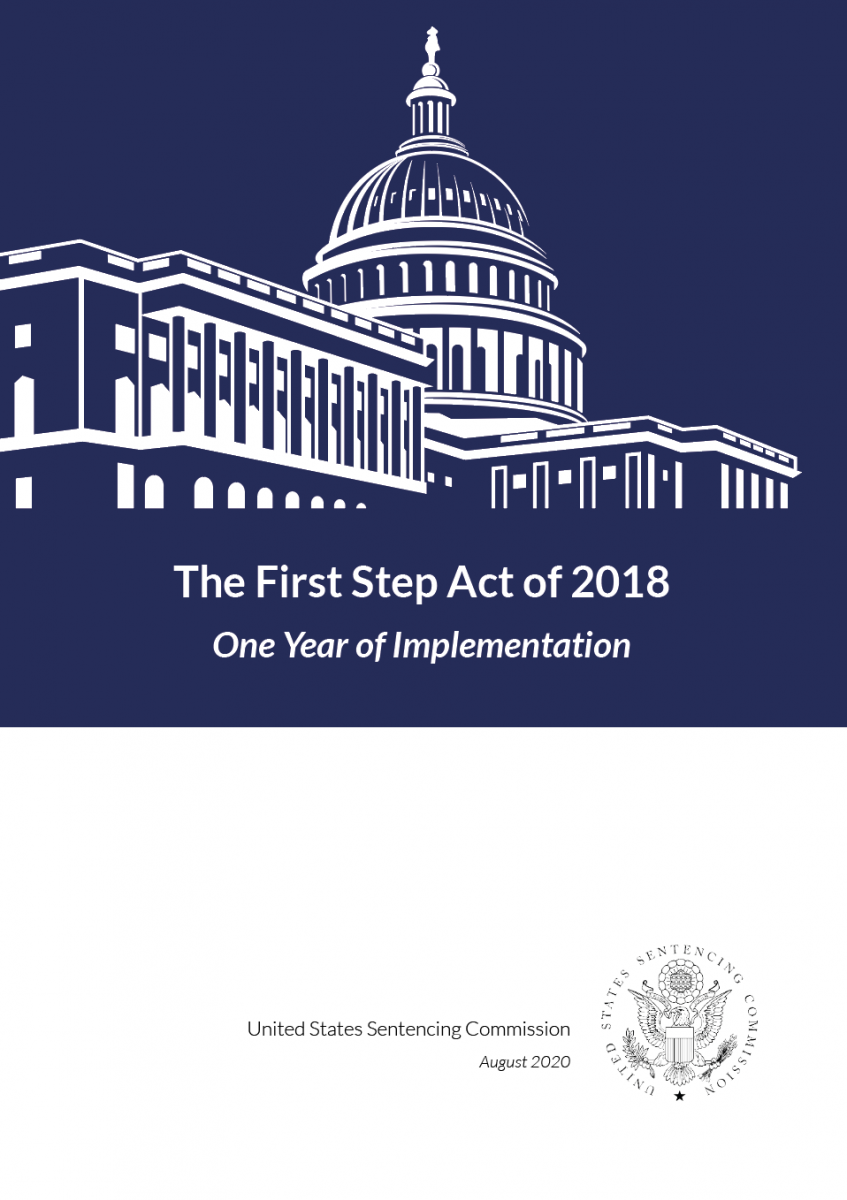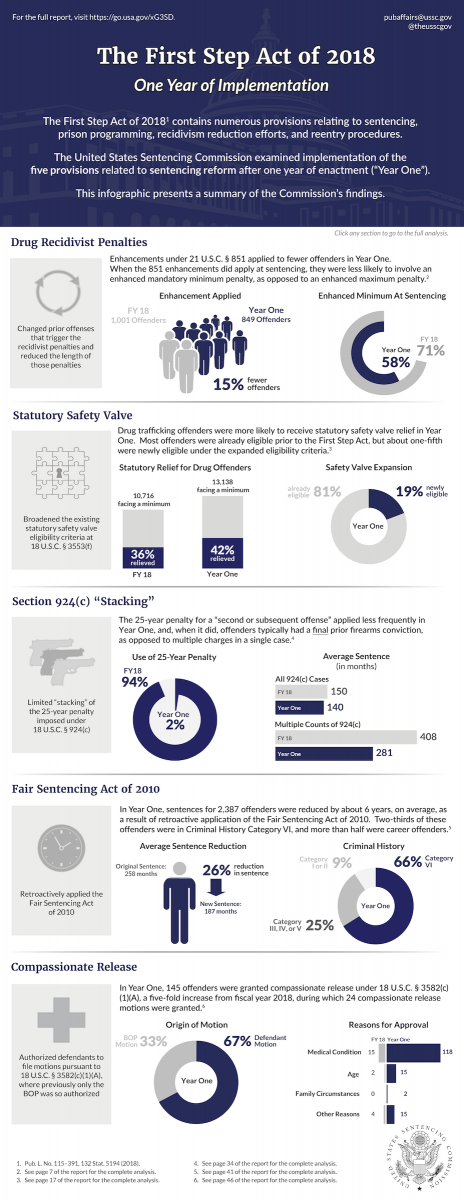Overview
(Published August 31, 2020) The First Step Act of 2018 includes five provisions related to sentencing reform. Each of these changes has been the subject of ongoing consideration within the criminal justice community and was the subject of Commission recommendations in its mandatory minimum reports and other work. The First Step Act has now been in effect for a full calendar year. This publication examines the impact of the First Step Act of 2018, analyzing data from the first year following its enactment, compared to data from fiscal year 2018—the last full fiscal year prior to its enactment.
Key Findings
Reducing Drug Recidivist Penalties
-
Enhanced recidivist penalties imposed pursuant to 21 U.S.C. § 851 applied to fewer offenders in First Step Year One, as a result of the First Step Act’s narrowing of qualifying prior drug offenses. When enhanced penalties did apply, they were less severe than in fiscal year 2018.
- The number of offenders who received enhanced penalties decreased by 15.2 percent, from 1,001 offenders in fiscal year 2018 to 849 offenders in First Step Year One.
- The new 15-year enhanced mandatory minimum penalty, which was reduced from 20 years by the First Step Act, applied to 219 offenders in First Step Act Year One. By comparison, the 20-year enhanced mandatory minimum penalty applied to 321 offenders in fiscal year 2018.
- The new 25-year enhanced mandatory minimum penalty, which was reduced from life imprisonment by the First Step Act, applied to 21 offenders in First Step Act Year One. The enhanced mandatory minimum penalty of life imprisonment (for an offense resulting in death or serious bodily injury) applied to only 11 offenders in First Step Act Year One. By comparison, the enhanced mandatory minimum penalty of life imprisonment applied to 42 offenders in fiscal year 2018.
-
Few offenders were exposed to an enhanced penalty, or exposed to a more severe enhanced penalty, on the new basis of a “serious violent felony” conviction.
- Of the 849 offenders for whom the section 851 information applied at sentencing, only 36 had been previously convicted of one or more qualifying “serious violent felony” offenses that was relied upon by the government to support an 851 enhancement.
- Of these 36 offenders, 25 also had at least one “serious drug felony” conviction. Only 11 offenders were exposed to an enhanced penalty solely based on one or more “serious violent felony” convictions.
- The most common “serious violent felony” convictions were weapons offenses, robbery, and aggravated assault.
Expanding Safety Valve
-
Offenders were more likely to receive relief from a mandatory minimum penalty or a reduction in sentence as a result of the First Step Act’s expansion of the safety valve eligibility criteria at 18 U.S.C. § 3553(f).
- In First Step Act Year One, of 13,138 drug trafficking offenders convicted of an offense carrying a mandatory minimum penalty, 41.8 percent (n=5,493) received statutory safety valve relief from the mandatory minimum penalty. By comparison, in fiscal year 2018, of 10,716 drug trafficking offenders convicted of an offense carrying a mandatory minimum penalty, 35.7 percent (n=3,820) received statutory safety valve relief.
- In First Step Act Year One, of 19,739 drug trafficking offenders, 36.1 percent (n=7,127) benefited from the safety valve, either by receiving relief from a mandatory minimum, a guideline reduction, or a variance based on the new expanded eligibility criteria. By comparison, of 18,349 drug trafficking offenders, 32.1 percent (n=5,885) benefited from the safety valve in fiscal year 2018.
-
Most drug trafficking offenders who received safety-valve relief in First Step Year One (80.8%; n=5,758) were “already eligible” for relief under the old safety valve criteria. There were 1,369 (19.2%) offenders “newly eligible” as a result of the First Step Act’s expanded criteria.
- Most newly eligible safety valve recipients qualified under the Act’s expanded criminal history provisions (87.9%; n=1,204).
- Newly eligible safety valve recipients received sentences on average 17 months longer than already eligible recipients, 53 months compared to 36 months.
- There were notable changes in the demographic characteristics, particularly in racial composition, between newly eligible and already eligible safety valve recipients. Newly eligible safety valve recipients were more likely to be White (30.9% compared to 16.2%) or Black (16.0% compared to 9.8%), and less likely to be Hispanic (49.9% compared to 70.5%) than already eligible recipients.
Limiting 924(c) "Stacking"
-
The 25-year penalty for a “second or subsequent offense” under 18 U.S.C. § 924(c) applied less frequently in First Step Year One, as a result of the First Step Act’s limitation of the penalty to section 924(c) offenders with a final prior firearms conviction, as opposed to those with multiple section 924(c) charges in a single case.
- In fiscal year 2018, one 25-year penalty was imposed consecutively to another firearm mandatory minimum penalty in most cases (92.1%; n=117) involving multiple section 924(c) counts. Multiple consecutive 25-year penalties were imposed in two cases (1.6%).
- In First Step Year One, out of the 215 cases involving multiple section 924(c) counts, the 25-year penalty was imposed in only five cases.
- In First Step Year One, five-, seven-, and ten-year penalties typically replaced what would have been a 25-year penalty prior to the First Step Act. In half (50.7%; n=109), a seven-year penalty was the highest penalty imposed, followed by ten years in 30.7 percent of cases (n=66) and five years in 14.0 percent of cases (n=30).
Retroactively Applying the Fair Sentencing Act of 2010
-
Since authorized by the First Step Act, 2,387 offenders received a reduction in sentence as a result of retroactive application of the Fair Sentencing Act of 2010.
- Offenders’ sentences were reduced, on average, by 71 months, from 258 months to 187 months.
- The majority (66.2%) of the offenders who received statutory relief under the First Step Act were in Criminal History Category VI, and more than half (57.4%) were originally sentenced as career offenders.
Compassionate Release
-
In the first year after passage of the First Step Act, 145 offenders were granted compassionate release under 18 U.S.C. § 3582(c)(1)(A), a five-fold increase from fiscal year 2018, during which 24 compassionate release motions were granted.
- In two-thirds of these cases (67.1%; n=96), the offender filed a motion seeking relief, rather than the Bureau of Prisons, a procedural change authorized by the First Step Act.


